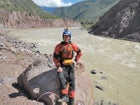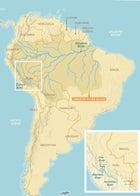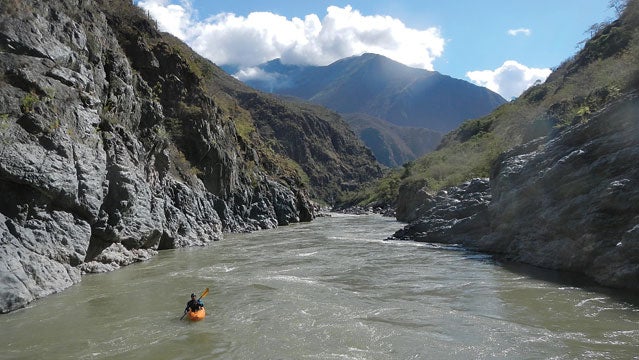The first source-to-sea descent of the Amazon River, completed by Polish kayaker Piotr Chmielinski and San Francisco newspaperman and rafting novice Joe Kane over the winter of 1985–86, was a six-month epic that claimed one of the last great adventure prizes. Chmielinski and Kane were two of just four people left standing after the 12-person expedition was held up at gunpoint by Shining Path rebels, consumed by infighting, and ultimately abandoned by its self-serving South African leader, François Odendaal. Kane’s 1989 book, Running the Amazon, was both a classic and a bestseller.
 Rocky Contos during his May descent of the Mantaro.
Rocky Contos during his May descent of the Mantaro. The source of all their troubles.
The source of all their troubles.But now it turns out that the trip may no longer count as the first descent. New evidence, currently under review by a respected scientific journal, makes the case that the tributary where Chmielinski and Kane put in, the Apurimac, isn’t the true source of the river. That’s a bit like saying Hillary and Tenzing climbed the wrong mountain. It also means that the first descent of the Amazon may once again be up for grabs. And in a race that’s reminiscent of the classic era of exploration, two rival paddlers are battling it out to the finish.
It might seem unbelievable that the Amazon’s source could have been overlooked for this long, but the starting point of a river is a somewhat arbitrary distinction, defined as the place from which water travels the greatest distance to reach the ocean. It was only in 2000 that an international team of scientists definitively declared the snowmelt on Peru’s 18,363-foot Nevado Mismi, above the Apurimac, to be the Amazon’s starting point. Except that it probably isn’t.
Last winter a San Diego whitewater-kayaking guide and former neuroscientist named James “Rocky” Contos, 41, was using Google Earth to plan a trip to Peru, to run the five major headwaters that feed the Amazon. As he plotted each of their lengths via GPS, he decided that the Mantaro, north and west of the Apurimac, was the real source. “I was looking at the maps and realized that the Mantaro is 50 miles longer than the Apurimac,” says Contos. He did a bit more research and learned that much of the Mantaro had never been paddled.
Contos immediately went to work on an article about his finding, submitting it last spring to the peer-reviewed British geography journal Area, which should make a decision on whether to publish the report in the next few months. He also rebooted his Peru plans to run the Mantaro and then keep going 4,000-plus miles down the Amazon to the Atlantic, capturing the first descent before anyone else knew it was back in play. Contos had the skills and mojo to pull it off—he’d notched numerous first descents in Mexico and had also run the Colorado River through the Grand Canyon, twice, without a permit—but not the funds to support such a lengthy endeavor.
So he started looking around for potential paddling partners who might share costs for sections of the trip. In March, he came across the website for an expedition billing itself as the Amazon Express. The leader, West Hansen, a 50-year-old marathon flatwater paddler and social worker from Austin, Texas, was organizing a two-month source-to-sea sprint down the river. Contos reached out over email, and the two began swapping information. Initially, Contos described only his earlier plan to run the Amazon’s tributaries, which made him an attractive potential teammate to Hansen, who was looking for whitewater specialists to help get him through the Class V rapids at the top of the Apurimac.
Hansen declined to comment for this story, citing an agreement with National Geographic, which signed on to sponsor his trip this past summer, but Contos provided what he says is a complete record of their correspondence. In an email dated March 23, Hansen told him he could probably fund most of the trip in return for “your company and gear collaboration.”
Not long after that, Contos felt compelled to open up about the Mantaro, insisting that Hansen keep the news secret. Hansen found the claim credible but wasn’t sure he wanted to change his plans. “While I’m very interested in departing from the true source of the Amazon,” he wrote to Contos on April 2, “the 30-to-50-mile difference in the Mantaro and Apurimac will have little bearing upon my accomplishment to any but a select few.”
Hansen then put Contos in touch with Piotr Chmielinski. Now 60 and working as an environmental consultant in Virginia, Chmielinski offered advice to two of the three past expeditions that repeated the route he and Kane pioneered. When Contos explained his Mantaro discovery, Chmielinski agreed to join him for a two-week reconnaissance of the tributary and secured a $7,500 grant from National Geographic for the project.
In early May, after the recon was completed and Chmielinski had left Peru, Contos and American kayaker James Duesenberry spent 23 days running the first descent of the Mantaro, arriving at its confluence with the Apurimac. As Contos figured it, he’d return at the end of the summer to hook up with Hansen for the long grind to the Atlantic. If Hansen stuck to his original plan to start on the Apurimac, Contos would have the first complete descent to himself. If Hansen switched to the Mantaro, they would share the glory. Either way, Contos would get what he was after.
But neither of those scenarios played out. It’s unclear why, but starting in May, Hansen’s replies to Contos’ emails came slower and slower. Contos began to worry that he was getting edged out and that Hansen would secretly set his sights on the Mantaro. Contos demanded that Hansen include him on any correspondence mentioning the Mantaro.
On June 26, Hansen responded to a Contos request for an update. “I’m sorry to have been out of pocket,” he wrote. “I am planning on doing the Mantaro.” He still invited Contos to join the expedition but suggested that because of scheduling challenges—Contos was committed to guiding another Peru trip in mid-August—he might have to meet them somewhere lower on the Amazon.
That fueled Contos’ concerns. If he didn’t link up with Hansen, or figure out a way to do the run himself, Hansen would claim the first descent. On July 28, feeling certain that he’d been cut out of the loop, Contos wrote to Hansen that he planned to use commercial motor boats to speed down the long flat-water sections of the Amazon. “You would still complete your original goals of fastest ever [paddling trip] down the entire Amazon,” he wrote. “I would be able to claim the first descent.” Hansen never replied.
A week later Contos snapped, lashing out at Hansen over email and accusing him of bad faith. Soon after, Contos began peppering his National Geographic contacts with lengthy screeds. “I want to make it clear that I WILL COMPLETE MY DESCENT BEFORE WEST,” he wrote, “and therefore have claim to the FIRST DESCENT OF THE AMAZON.” When contacted for comment, a spokesperson for National Geographic confirmed that the organization was funding both trips and that Hansen’s expedition would likely be covered in National Geographic magazine. As for Contos’ big discovery, it would await Area’s determination.
In late August, Hansen’s spokesman, David Kelly, sent Contos a terse email telling him he was officially off the team, citing the “tenor and content of the feelings expressed by you about West.” Contos sees it differently. He told me Hansen “didn’t want another guy who’s an expedition leader. He wanted to call all the shots.”
Chmielinski, who continued to consult with both men throughout the summer, hoped to play the peacemaker, just as he had in 1986. “I was trying to get everybody in some stage of cooperation,” he says. “Rocky is very strong—hardheaded. He’s a good man and means well, but sometimes he’ll create some conflict, which he’ll later regret.” Indeed, Contos’ career as a neuroscientist came to an end in 2008 after he accused a fellow postdoc of fudging data for a study on the mechanics of smell. Buck retracted the paper the data appeared in without admitting fault in an incident that made national news and cost Contos his job.
By October, assuming he stuck to his revised plan, Hansen had completed the Mantaro. But he made no mention of the tributary on his Amazon Express website. Instead, he acted as if he was sticking with the established source, creating a page titled The Route that said, “thus, we begin with the Apurimac.” (Kelly declined to answer questions about the route.)
With Hansen’s expedition not slated to be completed until mid-November, Contos made good on his plan to motor to the sea. After finishing all of the whitewater sections of the lower Apurimac in September, he boarded a barge and sped past Hansen’s team to reach the Atlantic in early November, securing the first descent—if the Mantaro holds up as the Amazon’s real source. This month, he planned to finish a draft of a book about the adventure, First Descent of the Amazon.
Ironically, when the two men were first in touch, Hansen was keenly aware of the internal battles that nearly destroyed Chmielinski and Kane’s expedition. “The main thing I learned … was what NOT to do with an expedition,” he wrote. “I’m being extremely careful in picking my teammates.” Perhaps just careful enough.

